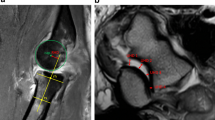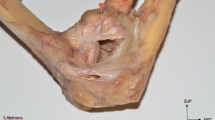Abstract
Purpose
To suggest a new model on the most common kind of posterior elbow dislocation using MRI findings on acute elbow injuries.
Methods
Fifteen patients with simple elbow dislocation (Group A) and 19 patients sustaining pure ligament injuries (Group B) were enrolled in this study. Using MRI scans, bony contusion at radial head and posterior capitellum (lateral bone contusion) and medial aspect of the ulnohumeral joint (medial bone contusion) were investigated with the injury patterns of the collateral ligament and overlying muscles. In Group A, the injury patterns of the ulnar and lateral ulnar collateral ligaments were classified into distraction or stripping type; in Group B, into rupture or strain. Based on these findings, we speculated the injury mechanism of the elbow dislocation.
Results
In Group A, posterolateral (PL) dislocation was found in 12 cases of distractive ulnar collateral ligament type and stripping lateral ulnar collateral ligament type, where lateral bone contusion was found in 11 cases. Posteromedial (PM) dislocation was observed in only two cases of distraction type of the LUCL, where medial bone contusion was seen in two cases. In PL dislocation of the elbow joint, we always found more severe damage of soft tissue at the medial side of the elbow joint compared to the lateral side. Lateral bone contusion was speculated to be caused by bony abutment under pathologic forearm external rotation (PFER) and medial bone contusion, by bony abutment under varus stress. In Group B, the ulnar collateral ligament was more commonly injured than the lateral ulnar collateral ligament, and lateral bone contusion accompanied most cases.
Conclusion
PL dislocation is thought to start from the medial side in contrary to PM dislocation beginning at the lateral side. If the disengagement of the coronoid process is not completed due to the insufficient valgus/varus distraction, a coronoid fracture will develop at the same time as the elbow dislocation during PFER.



Similar content being viewed by others
References
Fritz RC, Breidahl WH (2004) Radiographic and special studies: recent advances in imaging of the elbow. Clin Sports Med 23:567–580
Hobgood ER, Khan SO, Field LD (2008) Acute dislocation of the elbow joint. Hand Clin 24:1–7
Hildebrand KA, Patterson SD, King GJW (1999) Acute elbow dislocation; simple and complex. Orthop Clin N Am 30:63–79
Jeon IH, Micic ID, Yamamoto N, Morrey BF (2008) Osborne-Cotterill lesion: an osseous defect of the capitellum associated with instability of the elbow. Am J Roentgenol 191:727–729
Josefsson PO, Johnell O, Wendeberg B (1987) Ligamentous injuries in dislocations of the elbow joint. Clin Orthop Relat Res 221:221–225
Josefsson PO, Gentz CF, Johnell O, Wendeberg B (1987) Surgical versus nonsurgical treatment of ligamentous injuries following dislocations. Clin Orthop Relat Res 214:165–169
Josefsson PO, Gentz CF, Johnell O, Wendeberg B (1987) Surgical versus non-surgical treatment of ligamentous injuries following dislocation of the elbow joint. A prospective randomized study. J Bone Joint Surg Am 69(4):605–608
Kuhn MA, Ross G (2008) Acute elbow dislocation. Orthop Clin N Am 39:155–161
Lowden C, Garvin G, King GJW (2004) Imaging of the elbow following trauma. Hand Clin 20:353–361
O’Driscoll SW, Morrey BF, Korinek S, An KN (1992) Elbow subluxation and dislocation. A spectrum of instability. Clin Orthop Relat Res 280:186–197
Osborne G, Cotterill P (1966) Recurrent dislocation of the elbow. J Bone Joint Surg Br 48:340–346
Rosenberg ZS, Blutreich SI, Schweitzer ME, Zember JS, Fillmore K (2008) MRI features of posterior capitellar impaction injuries. Am J Roentgenol 90:435–441
Sojbjerg JO, Helmig P, Kjaersgaard-Andersen P (1989) Dislocation of the elbow: an experimental study of the ligamentous injuries. Orthopedics 12:461–463
Stevens KJ, McNally EG (2010) Magnetic resonance imaging of the elbow in athletes. Clin Sports Med 29:521–553
Kim SJ, Ji JH (2007) Irreducible posteromedial elbow dislocation: a case report. J Should Elbow Surg 16:e1–e5
Tuite MJ, Kijowski R (2006) Sports-related injuries of the elbow: an approach to MRI Interpretation. Clin Sports Med 25:387–408
Conflict of interest
Authors have no conflict of interest.
Author information
Authors and Affiliations
Corresponding author
Rights and permissions
About this article
Cite this article
Rhyou, I.H., Kim, Y.S. New mechanism of the posterior elbow dislocation. Knee Surg Sports Traumatol Arthrosc 20, 2535–2541 (2012). https://doi.org/10.1007/s00167-011-1872-7
Received:
Accepted:
Published:
Issue Date:
DOI: https://doi.org/10.1007/s00167-011-1872-7




